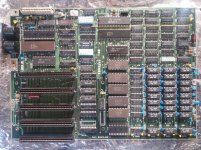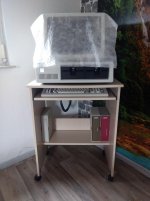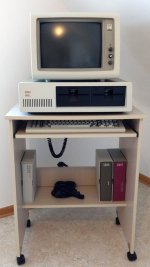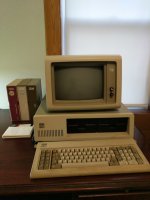Upcoming Events:
- VCF South West - June 14 - 16, Davidson-Gundy Alumni Center at University of Texas at Dallas
- VCF West - Aug 2 - 3, Computer History Museum, Mountain View, CA
- VCF Midwest - Sept 7 - 8 2024, Schaumburg, IL
- VCF SoCal - Mid February 2025, Location TBD, Southern CA
- VCF East - April 2025, Infoage Museum, Wall NJ
-
Please review our updated Terms and Rules here
You are using an out of date browser. It may not display this or other websites correctly.
You should upgrade or use an alternative browser.
You should upgrade or use an alternative browser.
40th anniversary of the IBM PC 5150
- Thread starter fs5500
- Start date
atg
Member
Looking great!
Agent Orange
Veteran Member
Very nice and very fortunate.
vwestlife
Veteran Member
It kinda bugs me how nearly every photo celebrating the PC being introduced in 1981 shows it with the 5153 color monitor, which wasn't introduced until 1983.
A true 1981 color PC would have some ugly aftermarket monitor, or even better, a clicker-knob-tuner TV set with a Sup'R'Mod.
A true 1981 color PC would have some ugly aftermarket monitor, or even better, a clicker-knob-tuner TV set with a Sup'R'Mod.
NeXT
Veteran Member
Gotta have the color monitor that everyone wanted back then, right? 
I thought I had a 5151 in storage but it turns out I do not.
I thought I had a 5151 in storage but it turns out I do not.
modem7
10k Member
Hmm. Might be time for me to sell my early 5150.
It's even worse. Magazines in Germany like the well-known "c't" even showed the 5150 with a hard disk.It kinda bugs me how nearly every photo celebrating the PC being introduced in 1981 shows it with the 5153 color monitor, which wasn't introduced until 1983.
Ruud
Veteran Member
I never thought about using a DOM in combination with XT-IDE. I do have some 32 MB ones laying around but didn't have use for them until now: 1) a bit too small for what I had in mind and 2) I still have no idea how to program them (no real effort to find out, to be honest). A pointer to a site or what ever would be welcome!I still have a near-mint 5150 on display. Fully working, never needed any repairs and untouched except of the addition of an 8087 and XT-IDE with a 32 MB DOM booting DOS 5.0.
FYI: I am using MS-DOS 3.31 in combination with a CF card. 3.31 leaves more memory free the 5.0 or 5.22 and is able to support bigger partitions. This makes it easier to exchange data with my 6.22 systems using, for example, 128 MB CF cards. Or I pop out its CF card and write the data directly to it with the 6.22 system. But I also think that 5.0 and better are to modern for a 8088 machine and should be used with 386+ ones. It is just a feeling and I wouldn't hesitate to use 5.0 or better if it suits my purpose.
A DOM will work just like any IDE hard disk. There's no special way to "program" it.
I use MS-DOS 5.0 mainly because older versions did cause the system to freeze when XT-IDE tried to boot. No idea why, but DOS 5.0 worked, so I stuck with it.
I have a whole bag of new 128 MB DOMs. A shop here in Germany sold them very cheap some time ago and I ordered 20+ of them - 'cause you never know. :D I used a 32 MB one to keep the system at least somehow authentic.
I use MS-DOS 5.0 mainly because older versions did cause the system to freeze when XT-IDE tried to boot. No idea why, but DOS 5.0 worked, so I stuck with it.
I have a whole bag of new 128 MB DOMs. A shop here in Germany sold them very cheap some time ago and I ordered 20+ of them - 'cause you never know. :D I used a 32 MB one to keep the system at least somehow authentic.
Ruud
Veteran Member
You are right. I mixed it up with the DiskOnCHip. But you still triggered a good idea: use these DiskOnChips in combination with XT-IDE.A DOM will work just like any IDE hard disk. There's no special way to "program" it.
Last edited:
T-R-A
Veteran Member
Remember hearing the announcement on the radio. Knew it meant something big as the "PC" world at the time was fragmented and pretty much 8-bit and significantly "home-brew". Of course, like everyone else, I had no idea as to the double-edge-sword world it'd lead to.
Eudimorphodon
Veteran Member
You are right. I mixed it up with the DiskOnCHip. But you still triggered a good idea: use these DiskOnChips in combination with XT-IDE.
Not sure why you’d want to bother unless you happen to have a pile of them lying around (which I guess you said you do) they’re discontinued and the remaining old stock is pretty terribly priced from a cost-per-megabyte perspective. (Cheapest I see them is $33 for 16MB. $33 is about the parts cost for a homemade XT-CF including the PCB and an IDE to SD adapter.
Re: programming those things they’re supposed to have a PC compatible BIOS already on them (I’m not sure if it’s 8088 compatible?) so it should just work as a disk drive if you place it in a decoded socket in the BIOS extension area. I believe it uses a SRAM style JEDIC pin out so you will need a socket that has the write pin present.
voidstar78
Veteran Member
o7 Gratz on 40.
Here is my 5150, although it is from '84 (256KB "B" model, but it is still neither an XT or AT - since it is 63W PSU, bays are dual 5.25" 360K, and cassette port). The attach JPG filesize is ironically 640KB (original is much larger, but the cropped for-web version came out to 640KB). In the photo, I have Sopwith ready (actually Sopwith II, since it has the birds). That joystick I have isn't very good, but the color matches - it is good for Paratrooper though.
I didn't know Sopwith was multi-player until this past summer. Perhaps it can be combined with the new mTCP tools to make it multiplayer across modern internet!? (I forget if Sopwith uses Interlink, or some kind of serial connection -- maybe there is already some adapter to sling that protocol over IP?)
I wrote DestinyHunter for the 40x25 Commodore PET. In porting that to the IBM PC, I didn't realize MDA didn't support a 40 character wide mode, that was only CGA. So unfortunately my port only uses the CGA text-mode addresses (in same 40x25 mode) [and I haven't finished adding audio to the PC version, but the 32K PET version has audio].
But now with mTCP available and working very well - I am kind of motivated to try to make some kind of 8088-based multiplayer network game.
Also, I wanted to be able to load my DHUNTER.COM from cassette (as I can on the PET -- which is only about 50 CPS, so it takes about 9 minutes to load!! I think the PC cassette is 200-300 CPS?). Mostly I just wanted to demonstrate that the program isn't dependent on DOS [or to demonstrate how it could be a useful machine, even if you happened to have no disk drives at all -- you could still load things from a tape via Cassette BASIC].
Except I can't find a way to WRITE the program to tape (the 5150CAXX.EXE program didn't work for me, and as a 32K program DHUNTER is too large to just bake into a long sequence of DATA values in a BASIC program the just POKEs into RAM {even if I could, I don't have a way to "paste" that into Cassette BASIC and do the initial recording to tape - I'd have to print it and type 32,000 hex values correctly}). But I have so many other projects now, I'm not sure if I'll get back to this.
BTW, I am trying to find a CCR-82 in clean/good condition. I have the CCR-81, but that's large and the one I have the door hinge doesn't hold open. (it still works ok, just I think the smaller -82 would be more cute next to a 5150 -- unless there some other suitable "small cassette" deck?).
And while I have an original MDA/CGA card, I did source an ISA VGA just so I don't have to use an MDA-to-VGA adapter. [those adapters work fine, but need the extra power so it's more annoying cabling]. An "authentic" monitor would be nice, but I'm in a no rush for it. [ it'd be nice to show how the original 63W power supply was designed to have a cable from it, going to the monitor ]
I did toss in an RJ45 ISA NIC, thankfully the modified 3COM driver on github works. Then after adding the XT-IDE, I just disabled the disk drives (removed their power cables) and just keep the disk drive dust cover on full time. [ although I'm working on a 37-pin to 34-pin adapter, so I can use the external floppy connection - I really don't want to open the case up more then I have to at this point ] The NIC is fun thanks to the mTCP tools - I can FTP files on without removing the CF card, or do some IRC, and use SNTP to set the system clock sync'd to a website during startup.
And I did add an ISA SB 2.0 - I can play MOD files just fine at ~13 KHz (that's fun since I can shuffle play them, like a 5150 powered juke box), but other then that things like Lemmings, SimCity, KQ4 are just to slow on the 4.77 MHz 8088. I'm ok sticking with mostly pre-1988 titles. I'm also realizing we kind of need a list of what software can function on a 64KB-only, 256KB-only, and 512/640KB only setup. The 3COM driver SETUP CFG requires over 256KB, and also basically any DOS installation from 4.0 or newer requires over 256KB (to do the install, not necessarily to boot the DOS after the install is finished).
Also the WiModem232 is fun, through the serial port [ except I only have 1 serial port, so it competes with the serial mouse ]. Maybe this device too could be used as a point-to-point data channel for games like Sopwith?
My notes using WATCOM C to do programming on a modern machine to make a real-mode .COM program for 8088 (tiny model limited to single segment of 64K):
https://destinyhunter.org/ibm-5150-development-notes/
In-work notes of my 5150 setup:
https://destinyhunter.org/voidstar-ibm-pc-5150/
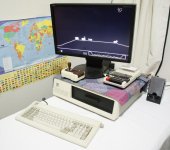
Here is my 5150, although it is from '84 (256KB "B" model, but it is still neither an XT or AT - since it is 63W PSU, bays are dual 5.25" 360K, and cassette port). The attach JPG filesize is ironically 640KB (original is much larger, but the cropped for-web version came out to 640KB). In the photo, I have Sopwith ready (actually Sopwith II, since it has the birds). That joystick I have isn't very good, but the color matches - it is good for Paratrooper though.
I didn't know Sopwith was multi-player until this past summer. Perhaps it can be combined with the new mTCP tools to make it multiplayer across modern internet!? (I forget if Sopwith uses Interlink, or some kind of serial connection -- maybe there is already some adapter to sling that protocol over IP?)
I wrote DestinyHunter for the 40x25 Commodore PET. In porting that to the IBM PC, I didn't realize MDA didn't support a 40 character wide mode, that was only CGA. So unfortunately my port only uses the CGA text-mode addresses (in same 40x25 mode) [and I haven't finished adding audio to the PC version, but the 32K PET version has audio].
But now with mTCP available and working very well - I am kind of motivated to try to make some kind of 8088-based multiplayer network game.
Also, I wanted to be able to load my DHUNTER.COM from cassette (as I can on the PET -- which is only about 50 CPS, so it takes about 9 minutes to load!! I think the PC cassette is 200-300 CPS?). Mostly I just wanted to demonstrate that the program isn't dependent on DOS [or to demonstrate how it could be a useful machine, even if you happened to have no disk drives at all -- you could still load things from a tape via Cassette BASIC].
Except I can't find a way to WRITE the program to tape (the 5150CAXX.EXE program didn't work for me, and as a 32K program DHUNTER is too large to just bake into a long sequence of DATA values in a BASIC program the just POKEs into RAM {even if I could, I don't have a way to "paste" that into Cassette BASIC and do the initial recording to tape - I'd have to print it and type 32,000 hex values correctly}). But I have so many other projects now, I'm not sure if I'll get back to this.
BTW, I am trying to find a CCR-82 in clean/good condition. I have the CCR-81, but that's large and the one I have the door hinge doesn't hold open. (it still works ok, just I think the smaller -82 would be more cute next to a 5150 -- unless there some other suitable "small cassette" deck?).
And while I have an original MDA/CGA card, I did source an ISA VGA just so I don't have to use an MDA-to-VGA adapter. [those adapters work fine, but need the extra power so it's more annoying cabling]. An "authentic" monitor would be nice, but I'm in a no rush for it. [ it'd be nice to show how the original 63W power supply was designed to have a cable from it, going to the monitor ]
I did toss in an RJ45 ISA NIC, thankfully the modified 3COM driver on github works. Then after adding the XT-IDE, I just disabled the disk drives (removed their power cables) and just keep the disk drive dust cover on full time. [ although I'm working on a 37-pin to 34-pin adapter, so I can use the external floppy connection - I really don't want to open the case up more then I have to at this point ] The NIC is fun thanks to the mTCP tools - I can FTP files on without removing the CF card, or do some IRC, and use SNTP to set the system clock sync'd to a website during startup.
And I did add an ISA SB 2.0 - I can play MOD files just fine at ~13 KHz (that's fun since I can shuffle play them, like a 5150 powered juke box), but other then that things like Lemmings, SimCity, KQ4 are just to slow on the 4.77 MHz 8088. I'm ok sticking with mostly pre-1988 titles. I'm also realizing we kind of need a list of what software can function on a 64KB-only, 256KB-only, and 512/640KB only setup. The 3COM driver SETUP CFG requires over 256KB, and also basically any DOS installation from 4.0 or newer requires over 256KB (to do the install, not necessarily to boot the DOS after the install is finished).
Also the WiModem232 is fun, through the serial port [ except I only have 1 serial port, so it competes with the serial mouse ]. Maybe this device too could be used as a point-to-point data channel for games like Sopwith?
My notes using WATCOM C to do programming on a modern machine to make a real-mode .COM program for 8088 (tiny model limited to single segment of 64K):
https://destinyhunter.org/ibm-5150-development-notes/
In-work notes of my 5150 setup:
https://destinyhunter.org/voidstar-ibm-pc-5150/

Attachments
Last edited:
voidstar78
Veteran Member
NOTE, I wanted to add.... I used OS/2 WARP in 1994, a full year before Windows 95 release. I'm not anti-Microsoft, but I do wish OS/2 could have thrived. IBM did some great stuff back then. And maybe they still do, just we don't hear about it as much (except that Jeopardy AI haha). I was at Las Vegas once and a tech was doing a repair on one of the casino machines - I noticed that it was using OS/2 
Ruud
Veteran Member
In the past I scrapped some thin clients, that is how I got them. A pile? No, just four.unless you happen to have a pile of them lying around (which I guess you said you do)
That makes selling them also a nice option.... Cheapest I see them is $33 for 16MB. ...
To the outside world it looks like a 6264 (or equivalent) 8K*8 SRAM. The 2864 EEPROM has the same layout plus an extra pint that is not used by XT-IDE. Therefore the idea of replacing the 2864 with a DOC. But extra lines of code are needed to tell the system that the ROM the system sees isn't just a ROM but a data carrier as well. And that code needs to be integrated in the code of the XT-IDE. Which won't be that simple (at least for me). Rethinking things, is it worth the trouble? I don't think so. But just thinking about the whole idea was fun. And that matters in life.I believe it uses a SRAM style JEDIC pin out so you will need a socket that has the write pin present.

